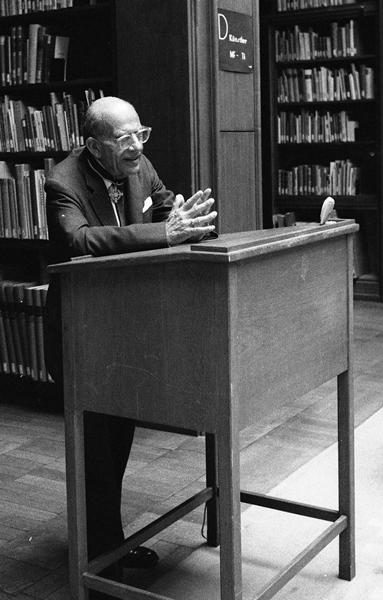Art historian Gerda Panofsky, the widow of Erwin Panofsky, brings our attention to pervading anti-Semitic prejudices in literature and academia
In an exclusive piece for the JVG, Gerda Panofsky brings our attention to pervading anti-Semitic prejudices in literature and academia. The author is the widow of art historian Erwin Panofsky whose habilitation treatise on Michelangelo was suppressed by his student Ludwig H. Heydenreich. In response to our report on this in our last issue, Gerda Panofsky tackles the continuing discriminatory presentation of her husband.
The nose is quite literally the most prominent feature of the human face. For that reason, it is nearly always damaged on the Greek marble statues excavated at archeological sites. Byzantine emperors neutralized their rivals and disqualified them from ruling by blinding them and cutting off their noses. Napoleon is said to have shot the nose off of the Sphinx with a cannonball during his Egyptian campaign of 1798/99.
There is also the pitiable fate of Tristram Shandy (the title character of the novel by Laurence Sterne, 1759-1767) who lost his nose to obstetric forceps during his birth. And Collegiate Assessor Kovalev temporarily loses his nose under mysterious circumstances in Nikolai Gogol’s absurd novel The Nose (1836).
The nose as asset and flaw
While the lack of a nose is a denigration, it is considered no less a flaw to have too large a nose. This is the exactly the theme of the Slawkenbergius Tale inserted into the novel Tristram Shandy. In Wilhelm Hauff’s fairy tale Zwerg Nase (“Little Longnose”) from 1827, an evil witch casts a spell on the 12-year-old Jacob.
“Everywhere he goes he hears the people cry, ‘Look at that ugly dwarf! What a long nose he has, and how his head is buried in his shoulders, and the swarthy ugly hands!’ […]. Jacob had been transformed into a hideous midget.”
His nose appeared even more grotesque in relation to his shrunken body. Hauff’s story is set in ‘Frankistan’ and is told by a Franconian slave who refers to his “dear fatherland, Germany.” In view of his Hebrew name and in light of the following tale titled Abner the Jew who Saw Nothing, one would not be far wrong in identifying Jacob as a tormented Jewish boy. Since the 1820s, obnoxious caricatures of Jews as wrinkled creatures with abnormally long noses had been flourishing.
Less than a century later, the stereotype of the Jew as small in stature and long of nose was expanded with another epithet – “old.” George L. Mosse (The Jews and the German War Experience 1914–1918) has demonstrated how in WWI the youthful hero of Apollonian beauty and manliness was being propagated as a German cult image.
This Siegfried archetype was steely, radiant, and muscular for whom the representatives of the “old” people of the Jews served as a perfect foil.
Young people with “old” faces
In German literature from this period, even young Jews usually have “old” faces. “Finally, the concept of beauty and eros which symbolized the ideal German confronted a Jewish stereotype which was its opposite: small and puny, ill-proportioned and with shambling gait”, says Mosse.
The 1920s then supplied us with pseudo-scientific justifications for these pre-judices which aided the National Socialists in building support for their persecution of Jews. In 1930, the third edition of Rassenkunde des Jüdischen Volkes (Racial History of the Jewish People) by Hans F. K. Günther (1891-1968) was published in Munich (initially printed in 1922 and 1927).
In a twist of fate, Günther was not only an exact contemporary of the art historian Erwin Panofsky (1892-1968) and – like the latter – earned his doctorate in 1914, but Günther too hailed from Freiburg im Breisgau where he held a professorship at Panofsky‘s alma mater from 1940-45.
In the chapter entitled “Individual Racial Characteristics in the Jewish People” of the aforementioned publication, Günther claims, “the Jews are, on average, short. The relatively low average height of Jews is probably attributable in most to relatively short legs. A stocky build seems, at least among the Jews living in the Occident and in Eastern Europe, to be more common …
One encounters Jews and Jewesses relatively often whose eyes appear to be bulging outward. The upper eyelids appear especially heavy. It is this formation of the upper eyelid that often lends Jewish faces a tired expression.… The excessively protrusive and crooked ‘Jewish nose’ often seen in depictions of Jews is encountered in reality much less frequently than is commonly believed.
It seems that the features of the ‘Jewish nose’ […] were so striking to Western peoples that the impression of this conspicuous feature came to fully define the ‘authentic Jew’ in the Western imagination.”
In his most recent novel, Il Cimitero di Praga (2010, The Prague Cemetery) Umberto Eco parodies such platitudes: “All I know about the Jews is what my grandfather taught me: […] My grandfather described those eyes that spy on you […], that nose of theirs like the beak of some southern bird … and those eyes, oh those eyes […] framed by a thousand tiny wrinkles that deepen with age, and already at twenty the Jew seems shriveled like an old man […]. [The Jews have a] dwarfish build.”


